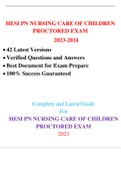-
1. Examen - Hesi community health proctored exam (new 2023,38 exam sets) / community health hesi ...
-
2. Examen - Hesi pn community health proctored exam (new 2023,39 exam sets) / community health he...
-
3. Examen - Hesi rn community health proctored exam (new 2023,39 exam sets) / community health he...
-
4. Examen - Hesi comprehensive exit exam (new 2023,38 exam sets) / comprehensive exit hesi exam (...
-
5. Examen - Hesi pn comprehensive exit exam (new 2023,39 exam sets) / pn comprehensive exit hesi ...
-
6. Examen - Hesi rn comprehensive exit exam (new 2023,39 exam sets) / rn comprehensive exit hesi ...
-
7. Examen - Hesi comprehensive predictor exam ( new 2023, 38 exam sets) / comprehensive predictor...
-
8. Examen - Hesi pn comprehensive predictor exam ( new, 39 exam sets) /comprehensive predictor pn...
-
9. Examen - Hesi rn comprehensive predictor exam ( new, 39 exam sets) /comprehensive predictor rn...
-
10. Examen - Hesi fundamentals proctored exam (new 2023,37 exam sets) / fundamentals proctored hes...
-
11. Examen - Hesi pn fundamentals proctored exam (new 2023,38 exam sets) / fundamentals pn proctor...
-
12. Examen - Hesi rn fundamentals proctored exam (new 2023,38 exam sets) / rn fundamentals proctor...
-
13. Examen - Hesi gerontology final exam quiz (new 2023,7 exam sets ) / gerontology hesi final exa...
-
14. Examen - Hesi leadership proctored exam ( new 2023, 38 exam sets)/ leadership hesi proctored e...
-
15. Examen - Hesi pn leadership proctored exam ( new 2023, 39 exam sets)/ pn leadership hesi proct...
-
16. Examen - Hesi rn leadership proctored exam ( new 2023, 39 exam sets)/ rn leadership hesi proct...
-
17. Examen - Hesi leadership management proctored exam (new 2023,37 exam sets) / leadership manage...
-
18. Examen - Hesi pn leadership proctored exam ( new 2023, 39 exam sets)/ pn leadership hesi proct...
-
19. Examen - Hesi rn leadership management proctored exam (new 2023,39 exam sets) / rn leadership ...
-
20. Examen - Hesi maternal newborn ob exam(new 2023,35 exam sets)/ maternal newborn ob hesi exam(n...
-
21. Examen - Hesi pn maternal newborn ob exam(new 2023,36 exam sets)/ pn hesi maternal newborn ob ...
-
22. Examen - Hesi rn maternal newborn ob exam(new 2023,37 exam sets)/ rn hesi maternal newborn ob ...
-
23. Examen - Hesi maternal newborn proctored exam (new 2023,37 exam sets) / maternal newborn hesi ...
-
24. Examen - Hesi pn maternal newborn proctored exam (new 2023,38 exam sets) / pn hesi maternal ne...
-
25. Examen - Hesi rn maternal newborn proctored exam (new 2023,38 exam sets) / rn hesi maternal ne...
-
26. Examen - Hesi maternity proctored exam (new 2023,37 exam sets) / maternity hesi proctored exam...
-
27. Examen - Hesi pn maternity proctored exam (new 2023,38 exam sets) / pn maternity hesi proctore...
-
28. Examen - Hesi med surg proctored exam (new 2023,36 exam sets) / med surg hesi proctored exam (...
-
29. Examen - Hesi pn med surg proctored exam (new 2023,37 exam sets) / pn med surg hesi proctored ...
-
30. Examen - Hesi rn med surg proctored exam (new 2023,38 exam sets) / rn med surg hesi proctored ...
-
31. Examen - Hesi mental health proctored exam (new 2023,37 exam sets) / mental health hesi procto...
-
32. Examen - Hesi pn mental health proctored exam (new 2023,38 exam sets) / pn mental health hesi ...
-
33. Examen - Hesi rn mental health proctored exam (new 2023,38 exam sets) / rn mental health hesi ...
-
34. Examen - Hesi nursing care of children proctored exam (new 2023,41 exam sets) / nursing care o...
-
35. Examen - Hesi pn nursing care of children proctored exam (new 2023,42 exam sets) / pn nursing ...
-
36. Examen - Hesi rn nursing care of children proctored exam (new 2023,42 exam sets) / rn nursing ...
-
37. Examen - Hesi pediatrics proctored exam (new 2023,37 exam sets)/ pediatrics hesi proctored exa...
-
38. Examen - Hesi pn pediatrics proctored exam (new 2023,38 exam sets)/ pn pediatrics hesi proctor...
-
39. Examen - Hesi rn pediatrics proctored exam (new 2023,38 exam sets)/ rn pediatrics hesi proctor...
-
40. Examen - Hesi pharmacology proctored exam (new 2023,38 exam sets) / pharmacology hesi proctore...
-
41. Examen - Hesi pn pharmacology proctored exam (new 2023,39 exam sets) / pn pharmacology hesi pr...
-
42. Examen - Hesi rn pharmacology proctored exam (new 2023,39 exam sets) / rn pharmacology hesi pr...
-
43. Examen - Hesi pn leadership management proctored exam (new 2023,39 exam sets) / pn leadership ...
-
44. Examen - Hesi rn maternity proctored exam (new 2023,38 exam sets) / rn maternity hesi proctore...
-
Montrer plus




